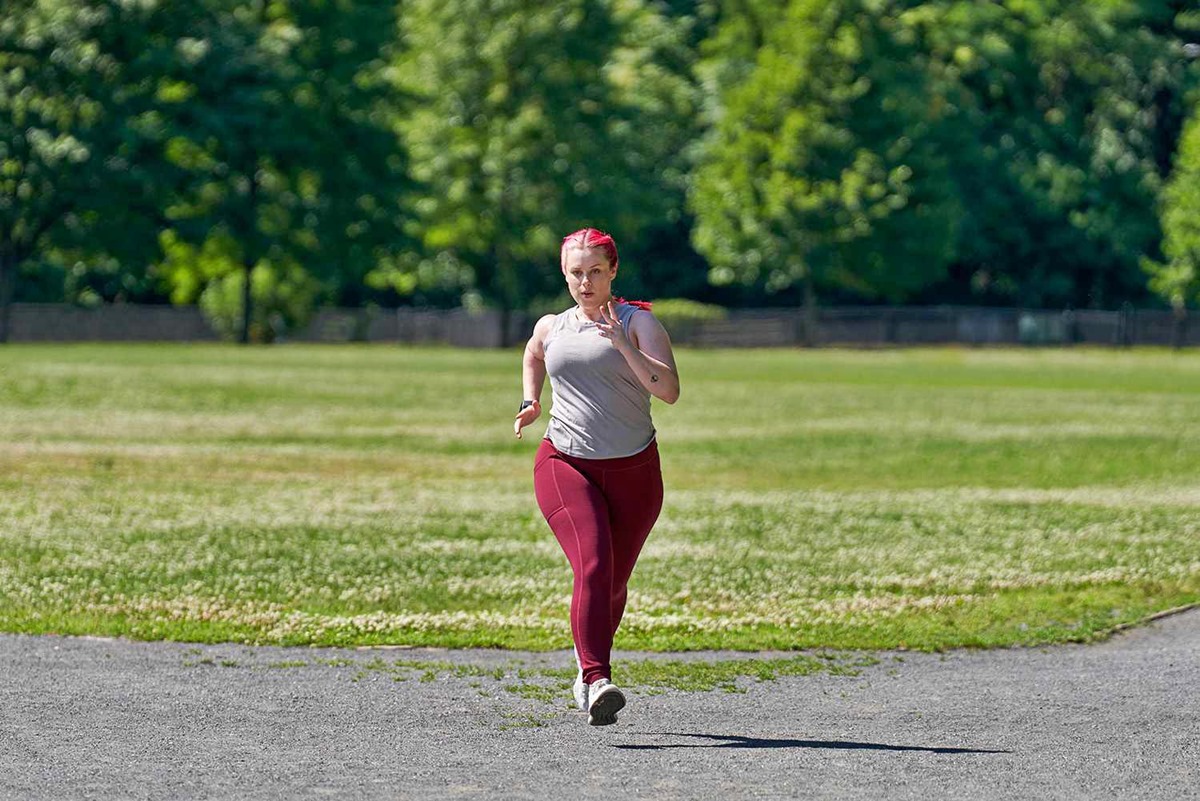Home>Misc>Featured>How To Improve Long Distance Running Form


Featured
How To Improve Long Distance Running Form
Modified: January 2, 2024
Discover effective strategies and tips to enhance your long distance running form, featured in this comprehensive guide on how to improve your technique and overall performance.
Introduction
Welcome to the world of long distance running! Whether you’re a seasoned marathoner or just starting to venture into the world of running, one thing is certain – the proper running form is crucial for your performance and overall enjoyment. Having good form not only helps you run efficiently, but it also reduces the risk of injury and enables you to maintain your pace for longer distances.
In this article, we will explore the importance of long distance running form, common mistakes that runners make, and provide you with valuable tips to improve your running form. We’ll also discuss strengthening exercises, stretching and mobility routines, breathing techniques, and how to monitor your progress and make adjustments along the way.
While running may seem like a simple activity, it involves several intricate movements that, when done correctly, can make a significant difference in your performance. By focusing on your form, you can optimize your running experience and take your performance to the next level.
So, whether you’re aiming to complete your first half marathon, conquer a full marathon, or simply want to improve your endurance and form, read on to discover the secrets to running with grace, efficiency, and speed over long distances!
Importance of Long Distance Running Form
When it comes to long distance running, having proper form is paramount. Your running form affects your efficiency, endurance, and overall performance. Here are a few reasons why focusing on your form is crucial:
- Efficiency: Good running form allows you to utilize your energy more efficiently. When your body is aligned and your movements are coordinated, you can propel yourself forward with minimal wasted energy. This means you can run longer distances without feeling fatigued too quickly.
- Injury Prevention: Running with poor form increases the risk of injuries. When you have inefficient or improper movements, you put unnecessary stress on your joints, muscles, and tendons. Over time, this can lead to overuse injuries such as shin splints, plantar fasciitis, and IT band syndrome. By maintaining proper form, you reduce the risk of injury and can enjoy running pain-free.
- Improved Performance: Correct running form can significantly enhance your performance. When your body is aligned and your movements are coordinated, you engage the appropriate muscles more effectively, resulting in more power and speed. This allows you to maintain a steady pace, sprint when needed, and conquer long distances with greater ease.
- Posture and Balance: Running with good form helps you maintain proper posture and balance. A strong and upright posture allows you to breathe more efficiently, maximizing your oxygen intake. It also helps distribute your weight evenly, preventing unnecessary strain on certain muscles and joints.
By focusing on your running form, you not only become a more efficient and injury-resistant runner but also set the foundation for greater endurance and improved overall performance. Now that we understand the importance of good form, let’s dive into the common mistakes that runners make and how to correct them.
Common Mistakes in Long Distance Running Form
When it comes to long distance running, many runners unknowingly make mistakes in their form that can hinder their performance and increase the risk of injury. By identifying these common mistakes and making the necessary adjustments, you can enhance your running efficiency and minimize the strain on your body. Here are some of the most common form errors to watch out for:
- Overstriding: Overstriding occurs when your foot lands too far in front of your body, creating a braking effect and increasing the impact on your joints. This can lead to inefficient movement and unnecessary strain on your legs. To address this, focus on increasing your cadence (step frequency) and landing with your foot underneath your body, rather than reaching out in front.
- Poor Upper Body Posture: Many runners have a tendency to hunch their shoulders or lean too far forward, which can lead to inefficient breathing and decreased running economy. Maintain an upright posture with relaxed shoulders, a slight forward lean from the ankles, and engage your core muscles to support your upper body.
- Weak Core Control: A weak core can lead to a breakdown in form, as it is responsible for maintaining stability and transferring power between the upper and lower body. Without a strong core, you may experience excessive rotation, side-to-side swaying, or a forward lean. Incorporate core-strengthening exercises like planks and Russian twists into your training routine to improve core stability.
- Inadequate Arm Swing: Your arms play a vital role in running form, as they help to propel you forward and maintain balance. Avoid clenching your fists or crossing your arms across your body. Instead, aim for a relaxed arm swing that moves in sync with your stride.
- Lack of Flexibility and Mobility: Limited flexibility and mobility can restrict your range of motion and cause compensatory movements that may lead to imbalances and injuries. Incorporate regular stretching exercises and mobility drills into your warm-up and cool-down routines to enhance your overall flexibility and mobility.
By being aware of these common mistakes and making the necessary corrections, you can improve your running form and optimize your long distance running experience. In the next section, we will provide you with valuable tips to enhance your long distance running form.
Tips to Improve Long Distance Running Form
Improving your long distance running form is essential for optimizing your performance and reducing the risk of injury. Here are some valuable tips to help you enhance your form and become a more efficient runner:
- Focus on Cadence: Increase your cadence, or steps per minute, to improve your running form. Aim for a cadence of around 180 steps per minute, as this can help reduce overstriding and minimize the impact on your joints. Use a metronome or running app with a built-in cadence feature to help you maintain a consistent rhythm.
- Run Tall: Maintain an upright posture while running. Imagine a string pulling you up from the top of your head, keeping your spine aligned. Engage your core muscles to provide stability and promote efficient movement.
- Relax Your Upper Body: Keep your shoulders relaxed and avoid tense arm movements. Let your arms swing naturally while maintaining a 90-degree bend at the elbow. This will help you maintain balance and efficient running mechanics.
- Land Midfoot: Aim to land on the middle of your foot, with a slight forward lean. Avoid landing on your heel, as it can increase the risk of injury and lead to inefficient running. This midfoot strike allows for better shock absorption and energy transfer.
- Breathe Properly: Focus on deep belly breathing to maximize oxygen intake while running. Inhale deeply through your nose and exhale through your mouth. This helps provide the necessary oxygen for your muscles and helps you maintain a steady rhythm.
- Visualize Your Form: Use visualization techniques during your runs to help reinforce proper running form. Imagine yourself running with perfect technique, maintaining a strong posture, and efficient stride. This mental imagery can help reinforce good habits and improve your overall form.
- Practice Good Running Hygiene: Pay attention to your running gear, footwear, and running surface. Invest in proper running shoes that provide adequate support and cushioning for your feet. Also, vary your running routes to include different surfaces, such as grass, track, or trails, to challenge your body and prevent overuse injuries.
Remember, improving your running form takes time and practice. Be patient and gradually incorporate these tips into your training routine. Consistency and focus will help you make significant strides in improving your long distance running form.
Strengthening Exercises for Long Distance Running Form
In addition to practicing good running form, incorporating specific strengthening exercises into your training routine can help improve your long distance running form. These exercises target the key muscles involved in running, enhancing your strength, stability, and overall performance. Here are some effective strengthening exercises to consider:
- Squats: Squats target your quadriceps, hamstrings, and glutes – muscles that propel you forward while running. Stand with your feet shoulder-width apart, lower your body into a squat position by bending your knees and pushing your hips back, and then return to the starting position. Start with bodyweight squats and gradually increase the resistance with dumbbells or a barbell as you get stronger.
- Lunges: Lunges strengthen your quadriceps, hamstrings, and glutes, while also improving your balance and stability. Step forward with one foot and lower your body until your front knee forms a 90-degree angle. Return to the starting position and repeat with the other leg. Add resistance by holding dumbbells or a medicine ball.
- Single-Leg Deadlifts: Single-leg deadlifts target your glutes, hamstrings, and core muscles, helping to improve balance and stability. Stand on one leg and hinge forward at the hips, extending your opposite leg straight behind you. Keep your back straight and return to the starting position. Repeat on the other leg.
- Planks: Planks are a fantastic exercise for strengthening your core muscles, including your abs, obliques, and lower back. Start in a push-up position, resting on your forearms, and hold your body in a straight line. Engage your core muscles and hold for as long as you can, aiming for at least 30 seconds to start with.
- Calf Raises: Strong calves are essential for a powerful push-off while running. Stand on the edge of a step or a raised platform with your heels hanging off the edge. Rise up onto your toes, then lower your heels below the step. Repeat for the desired number of repetitions.
- Hip Bridges: Hip bridges engage your glutes, hamstrings, and core muscles, promoting hip stability and power. Lie on your back with your knees bent and feet flat on the ground. Lift your hips off the ground, squeezing your glutes, and hold for a few seconds before lowering back down.
It’s essential to perform these exercises with proper form and gradually increase the intensity and resistance as your strength improves. Remember to listen to your body and consult with a fitness professional if you have any concerns or specific needs.
Stretching and Mobility Exercises for Long Distance Running Form
Stretching and mobility exercises are vital for improving your long distance running form. They help increase your flexibility, range of motion, and joint mobility, ultimately enhancing your overall running efficiency and reducing the risk of injury. Here are some effective stretching and mobility exercises to incorporate into your routine:
- Dynamic Warm-up: Before your run, start with dynamic warm-up exercises to increase blood flow and warm up your muscles. Perform exercises like leg swings, arm circles, walking lunges, and high knees to loosen up your joints and prepare your body for the workout ahead.
- Hip Flexor Stretch: Tight hip flexors can adversely affect your running form. Kneel on one knee, with your other leg bent in front at a 90-degree angle. Lean forward with your hips, keeping your back straight, until you feel a stretch in the front of your hip. Hold for 30 seconds and repeat on the other side.
- Hamstring Stretch: Lie on your back with one leg extended straight out and the other leg bent with the foot flat on the ground. Slowly raise the extended leg towards your chest, using a towel or strap to assist if needed. Hold for 30 seconds and repeat on the other leg.
- IT Band Foam Rolling: The iliotibial (IT) band can become tight and cause discomfort while running. Use a foam roller to apply pressure along the side of your thigh, from your hip down to your knee. Roll back and forth slowly, focusing on any tight or tender spots.
- Ankle Circles: Strong and flexible ankles are essential for maintaining proper form while running. Sit on the ground with your legs extended in front of you. Lift one foot off the ground and rotate your ankle in circles in both directions. Repeat with the other foot.
- Static Stretching: After your run, include static stretches to help cool down and lengthen your muscles. Perform stretches targeting your quadriceps, hamstrings, calves, and hip flexors. Hold each stretch for 20-30 seconds without bouncing.
Remember to perform these stretches in a controlled and comfortable manner, without any pain or discomfort. Incorporating them into your pre- and post-run routines will help improve your flexibility and mobility, allowing for better running form and reducing the risk of muscle imbalances or tightness.
Breathing Techniques for Long Distance Running Form
Proper breathing techniques are crucial for maintaining rhythm, optimizing oxygen intake, and enhancing your long distance running form. Here are some effective tips to help you breathe efficiently during your runs:
- Deep Belly Breathing: Take deep breaths that originate from your diaphragm, not shallow chest breaths. When you inhale, fill your belly with air, allowing it to expand fully. Exhale deeply, emptying your lungs completely. This type of breathing maximizes oxygen intake and improves your overall endurance.
- Establish a Rhythm: Sync your breathing with your running rhythm. It’s common to adopt the “2:2” pattern, where you inhale for two steps and exhale for two steps. However, you can adjust this to find a pattern that works best for you. Experiment with different ratios and find what feels most comfortable and natural.
- Focus on Exhaling Fully: Many runners tend to focus on inhaling deeply but neglect the importance of exhaling fully. Make a conscious effort to exhale fully, releasing all the stale air from your lungs. This creates space for fresh oxygen during the inhalation phase and helps reduce muscle tension.
- Coordinate Breathing with Footstrike: Coordinate your breathing rhythm with your footstrike to help maintain a steady and efficient running form. For example, some runners find it effective to inhale when their right foot hits the ground and exhale when the left foot hits the ground, or vice versa. Experiment with different patterns to find what feels most natural for you.
- Practice Diaphragmatic Breathing: Diaphragmatic breathing involves breathing deeply into your belly, engaging your diaphragm muscles. This type of breathing not only helps increase oxygen intake but also promotes relaxation and prevents shallow chest breathing. Practice diaphragmatic breathing during rest periods and incorporate it into your daily life to improve overall breathing efficiency.
- Relax Your Upper Body: Tension in your upper body can impede your breathing and waste energy. Keep your shoulders relaxed and avoid clenching your fists or hunching forward. A relaxed upper body allows for easier and more efficient breathing, helping you maintain your pace for longer distances.
Remember, breathing techniques play a significant role in your running performance. Experiment with different techniques during your training runs and find what works best for you. By adopting efficient breathing habits, you can enhance your endurance, minimize fatigue, and optimize your long distance running form.
Monitoring Progress and Making Adjustments
Monitoring your progress and making necessary adjustments are essential components of improving your long distance running form. By regularly assessing your performance and making tweaks along the way, you can continue to refine your technique and achieve better results. Here are some tips to help you monitor your progress and make effective adjustments:
- Keep a Running Journal: Maintain a running journal to track your workouts, distances, and times. This will allow you to monitor your progress over time, identify patterns, and determine which aspects of your form and training need improvement.
- Record Yourself: Film yourself running or have someone record you during a training session. Analyze the footage and look for any deviations from proper running form, such as overstriding or poor upper body posture. This visual feedback can help you pinpoint areas that require adjustment.
- Consult a Running Coach: Seeking guidance from a running coach or expert can provide valuable insights into your form and help identify areas for improvement. They can assess your running mechanics, offer personalized feedback, and provide specific drills or exercises to address any deficiencies.
- Listen to Your Body: Pay attention to any discomfort or pain during your runs, as this may indicate poor form or overuse injuries. If you experience persistent pain in a specific area, it may be necessary to modify your running form, adjust training volume, or seek professional advice.
- Gradual Progression: Make adjustments to your running form gradually to allow your body to adapt. Implementing too many changes at once can lead to muscle imbalances or injury. Focus on one aspect at a time, such as improving posture or increasing cadence, until it becomes natural before moving on to the next adjustment.
- Listen to Feedback: Seek feedback from experienced runners or fellow athletes. They may notice things about your form that you might overlook. Be open to constructive criticism and apply it to your training to make necessary improvements.
Remember, improving your long distance running form is an ongoing process. Regularly monitor your progress, assess your technique, and make gradual adjustments to continue progressing. By staying attentive and adaptable, you can refine your form and achieve your running goals.
Conclusion
Improving your long distance running form is an investment that yields numerous benefits. By focusing on proper form, you can enhance your running efficiency, reduce the risk of injury, and boost your overall performance. It’s a combination of various factors, including body alignment, technique, strength, flexibility, and breathing.
In this article, we explored the importance of long distance running form and identified common mistakes that runners make. We also provided valuable tips for improving your form, including focusing on cadence, maintaining good posture, engaging in specific strengthening exercises, practicing stretching and mobility routines, and adopting effective breathing techniques. Additionally, we discussed the significance of monitoring your progress and making necessary adjustments along the way.
Remember, improving your running form takes time, dedication, and consistency. Incorporate the tips and exercises mentioned in this article into your training routine gradually. Listen to your body, seek guidance from experts when needed, and be patient with your progress. With practice and perseverance, you will gradually develop efficient running form that will enhance your long distance running experience.
So, lace up your running shoes, focus on your form, and hit the road with confidence. Embrace the joy and challenge of long distance running, knowing that by prioritizing your form, you’re optimizing your performance, minimizing the risk of injury, and setting yourself up for success. Happy running!









